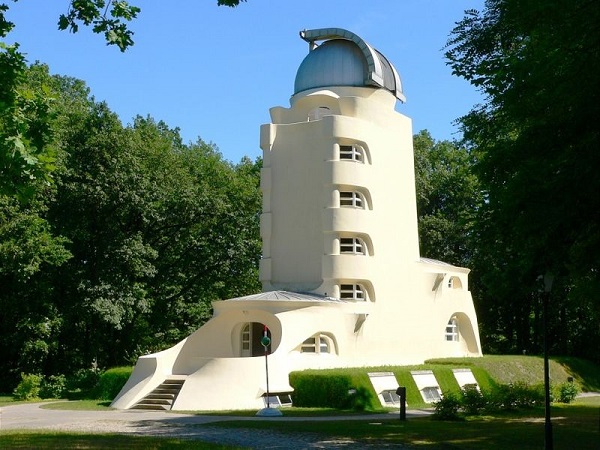Expressionist architecture
Expressionism emerged in Northern Europe in the early 20th century in poetry and painting, where it attempted to distort reality to express subjective, emotional experience. It quickly spread through all of the arts and architecture, pioneered by a group of architects from Germany, Austria and Denmark.
Expressionist architects used materials such as brick, concrete and glass to create novel sculptural forms and massing, sometimes distorted and fragmented to express an emotional perspective. Very often, expressionism involved a rejection of historical styles, symmetrical forms, and traditional designs, and instead embraced abstraction (based on structures not found or seen in the real world). This tended to result in unusual building forms using innovative construction techniques that stood out from their surroundings.
While the individualistic and informal approach to expressionist architecture makes it more difficult to define as a precise style, there are some recurring characteristics, including:
- Expressing emotion through distorted forms.
- Emphasis of symbolic or stylistic expression over realism.
- An attempt to achieve new and original designs.
- Natural themes such as mountains, lightning, rock formations, caves, and so on.
- Influence of Moorish, Egyptian, Indian and other eastern architectural styles.
- The romantic appreciation of architecture as an art form.
One of the landmark buildings of the expressionist form is the Einstein Tower by Erich Mendelsohn (see top image).
[edit] Related articles on Designing Buildings Wiki
Featured articles and news
RTPI leader to become new CIOB Chief Executive Officer
Dr Victoria Hills MRTPI, FICE to take over after Caroline Gumble’s departure.
Social and affordable housing, a long term plan for delivery
The “Delivering a Decade of Renewal for Social and Affordable Housing” strategy sets out future path.
A change to adoptive architecture
Effects of global weather warming on architectural detailing, material choice and human interaction.
The proposed publicly owned and backed subsidiary of Homes England, to facilitate new homes.
How big is the problem and what can we do to mitigate the effects?
Overheating guidance and tools for building designers
A number of cool guides to help with the heat.
The UK's Modern Industrial Strategy: A 10 year plan
Previous consultation criticism, current key elements and general support with some persisting reservations.
Building Safety Regulator reforms
New roles, new staff and a new fast track service pave the way for a single construction regulator.
Architectural Technologist CPDs and Communications
CIAT CPD… and how you can do it!
Cooling centres and cool spaces
Managing extreme heat in cities by directing the public to places for heat stress relief and water sources.
Winter gardens: A brief history and warm variations
Extending the season with glass in different forms and terms.
Restoring Great Yarmouth's Winter Gardens
Transforming one of the least sustainable constructions imaginable.
Construction Skills Mission Board launch sector drive
Newly formed government and industry collaboration set strategy for recruiting an additional 100,000 construction workers a year.
New Architects Code comes into effect in September 2025
ARB Architects Code of Conduct and Practice available with ongoing consultation regarding guidance.
Welsh Skills Body (Medr) launches ambitious plan
The new skills body brings together funding and regulation of tertiary education and research for the devolved nation.
Paul Gandy FCIOB announced as next CIOB President
Former Tilbury Douglas CEO takes helm.
UK Infrastructure: A 10 Year Strategy. In brief with reactions
With the National Infrastructure and Service Transformation Authority (NISTA).























